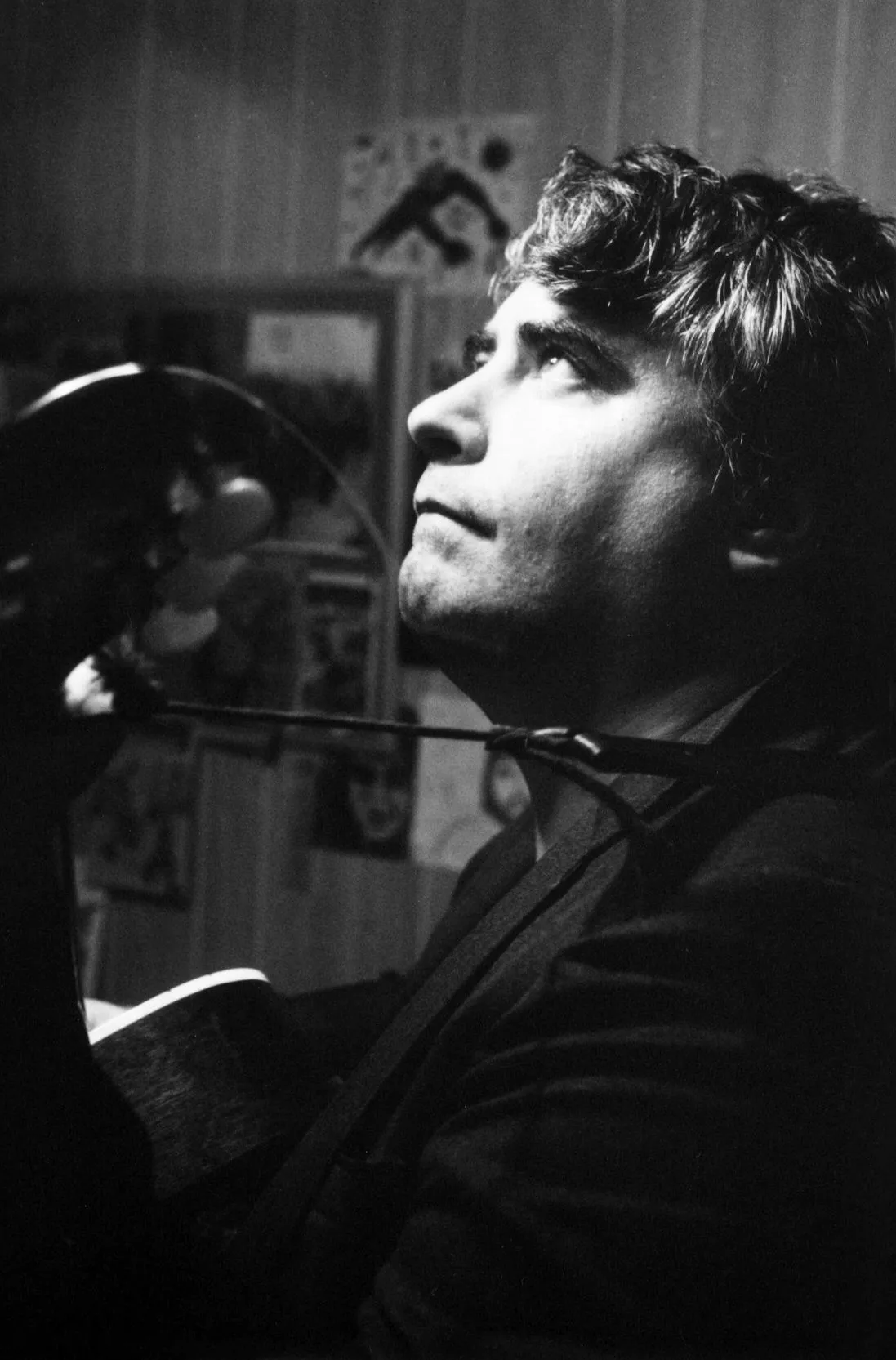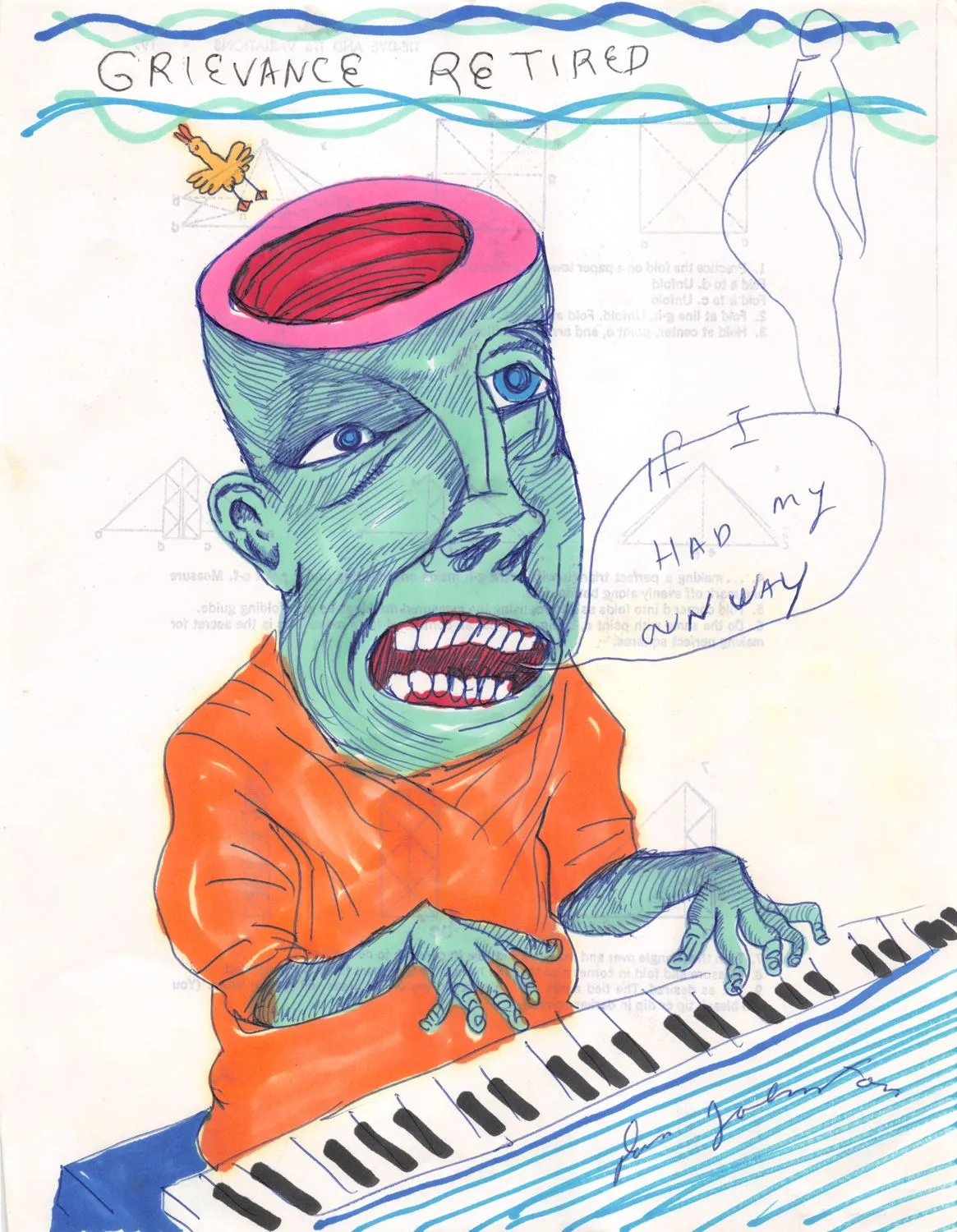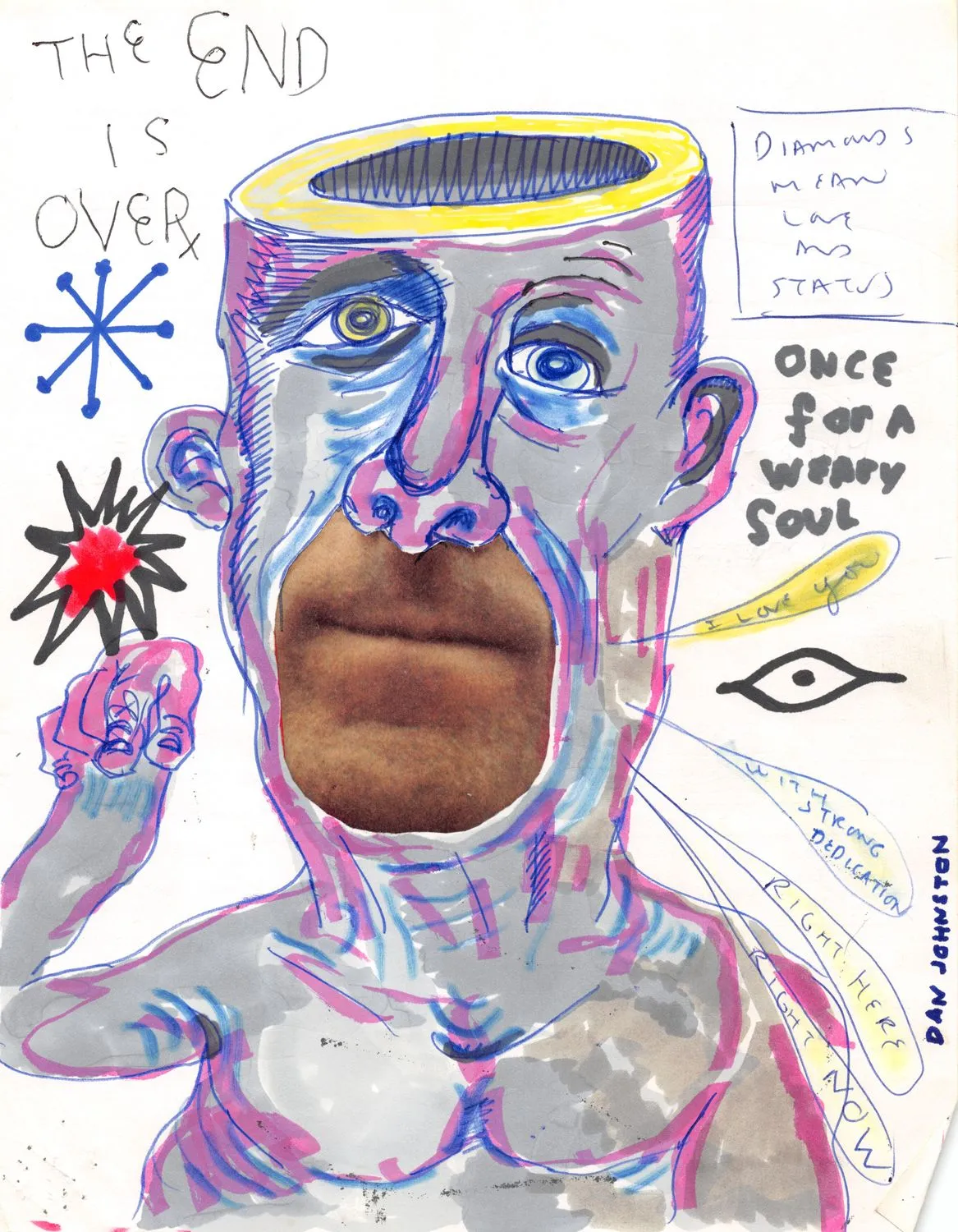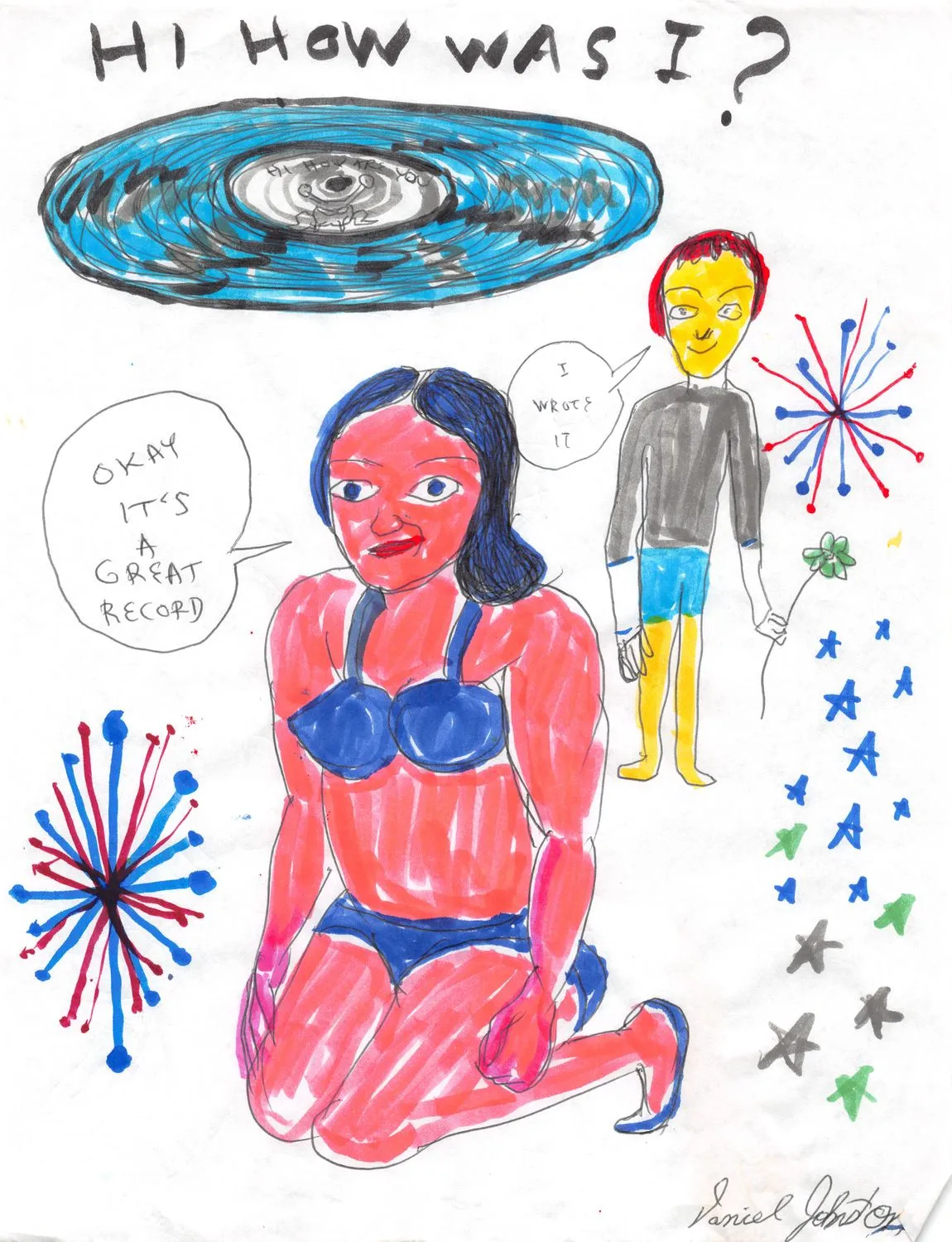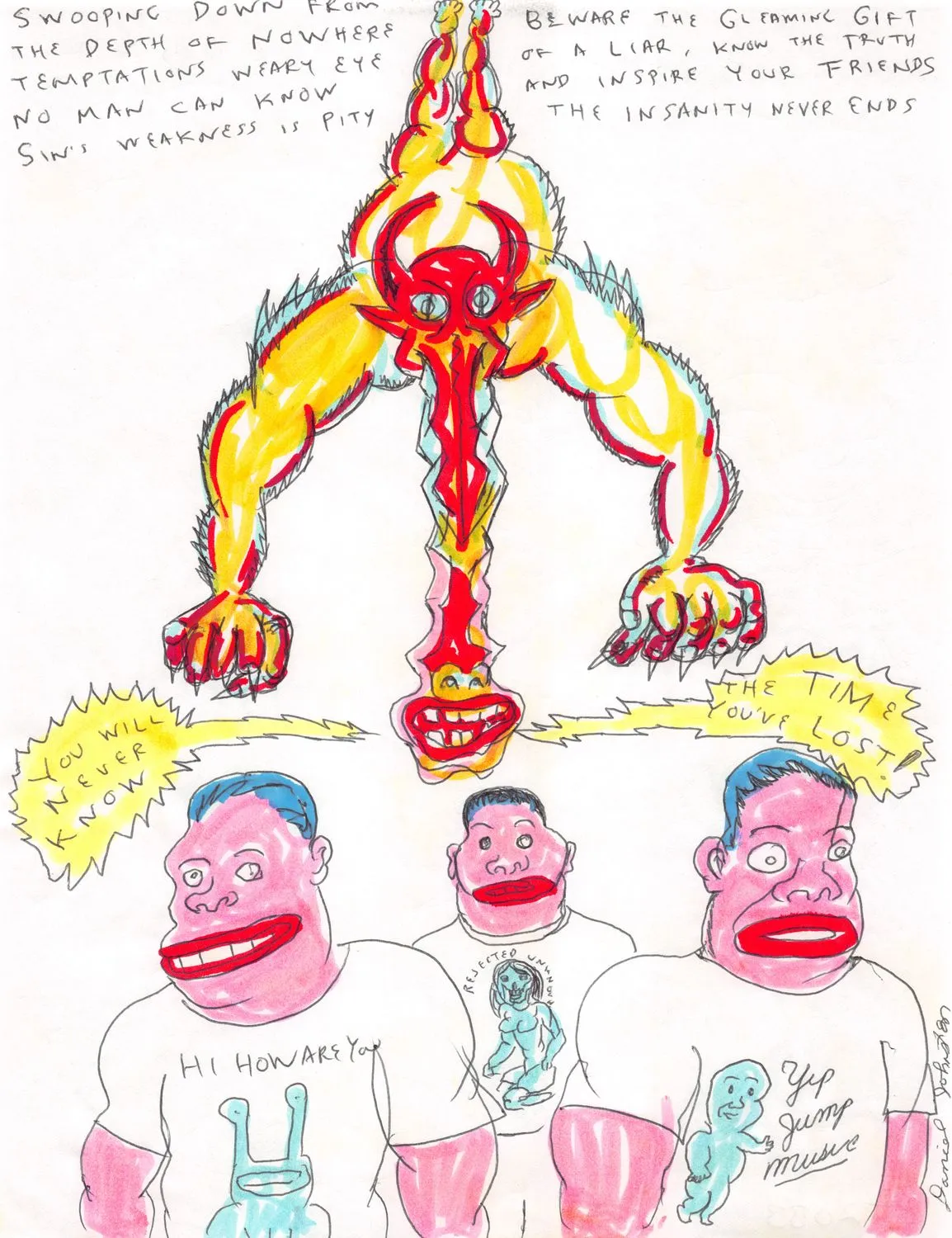 Daniel Johnston, Elusive Eye, c. 1965
Daniel Johnston, Elusive Eye, c. 1965 Art is world-forming: many artists live, breathe, and think their creations, revealing the deepest secrets of their inner worlds while commenting on our precarious present condition as well. However, Daniel Johnston (1961–2019), an artist and musician from the US, brought this assertion to the next level. In 2001, he created a drawing titled I Think, I Draw, I Am, featuring a masked green figure scribbling, with a speech bubble bearing the title words. But who is this figure—and the artist behind it? The red, grotesque, horned mask recalls a common representation of the devil, but the sad expression reveals an emotional complexity beyond the classical symbol of evil. Described as emotionally unguarded—a description that summarizes his art as well—Johnston created a universe of his own, populated by familiar heroes and expressive music.
In an exhibition eponymous with the mentioned drawing, staged presently at Pioneer Works in New York City, the curators aim to answer this question. We join them in this endeavour, offering a belated look at a creator who left a strong mark on indie music and the visual arts.
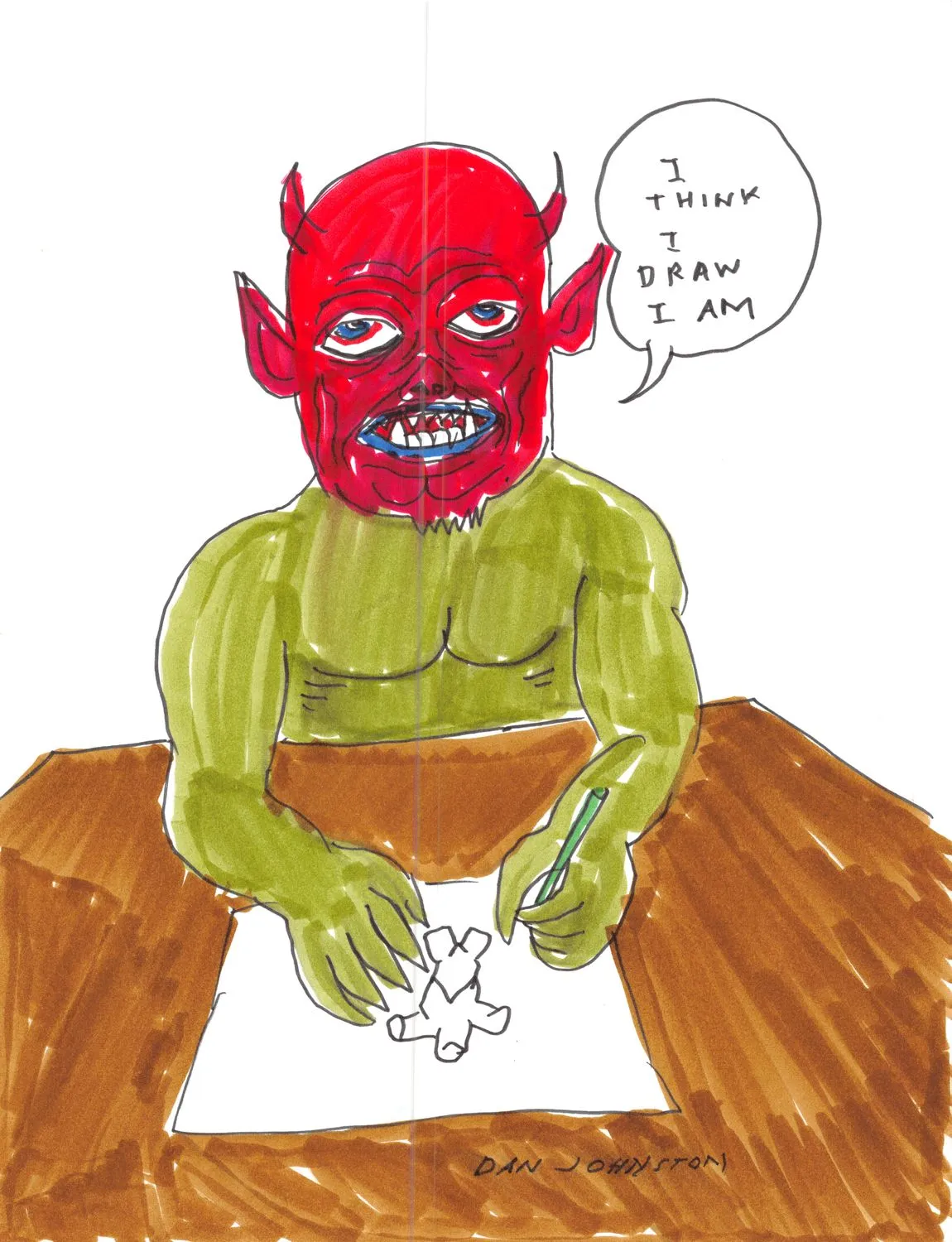
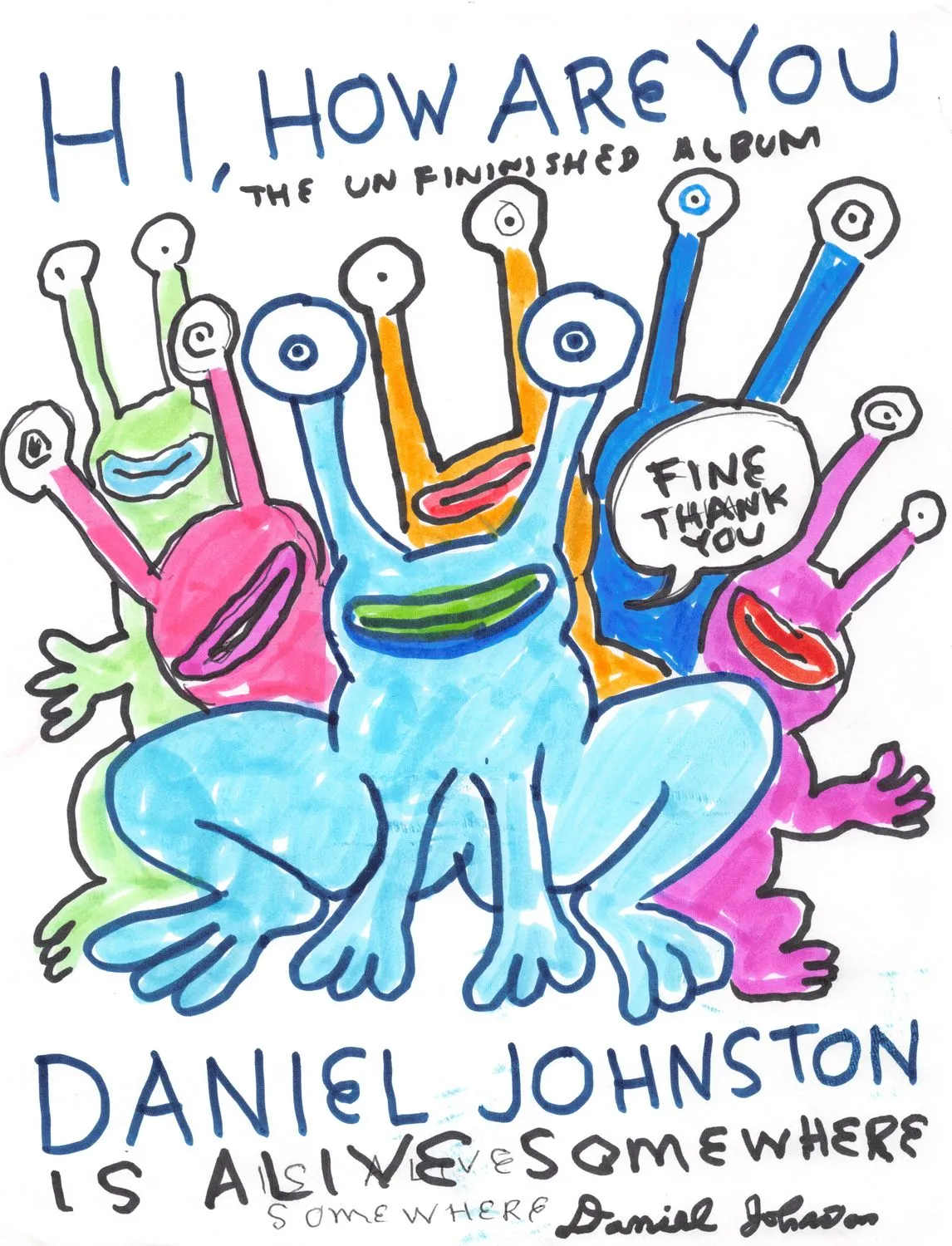
Although music is what mostly defined Daniel Johnston, he was also a visual artist with a passion for drawing. The most striking aspect of his practice is its openness and rawness, which translates into an exciting view into the artist’s inner state, his emotions, as well as his rugged mental health.
His entry into the music world came in the mid-1980s in Austin, Texas, where he established himself on the alternative lo-fi music scene. His self-promotion, perhaps the best illustration of his openness and honest, direct approach to music-making, consisted of handing out his home-recorded tapes, with covers featuring his illustrations, to anyone who was interested. This, together with his musical style combining indie folk, pop, and funk, along with his crackling voice and many imperfections, paints the image of an artist who embraced his own vulnerability and translated it into artistic expression in a way that connected with many.
Unguarded emotions and Johnston's talent as a songwriter come into full force in his most-adored creation, the minute-and-fifty-one-second-long True Love Will Find You in the End, a song from his 1990 album. His recognizable vocals urge listeners to never give up on finding love—"only if you’re looking can it find you"—even if this search begins from a place of rejection and loneliness. It is as much about others as it is an encouragement for himself, in moments when he faced these feelings. Simple and yet profound, the song uplifts and, at the same time, reveals the forlorn state of the human condition.
“The best thing you can say about me is that I have been and I always will be in the twilight zone, and I'm serious,” he explained in an interview with the Dallas Morning News.
I live a different life. I’m lonely, but it’s not just being lonely. It’s the things that I see and the way I think.
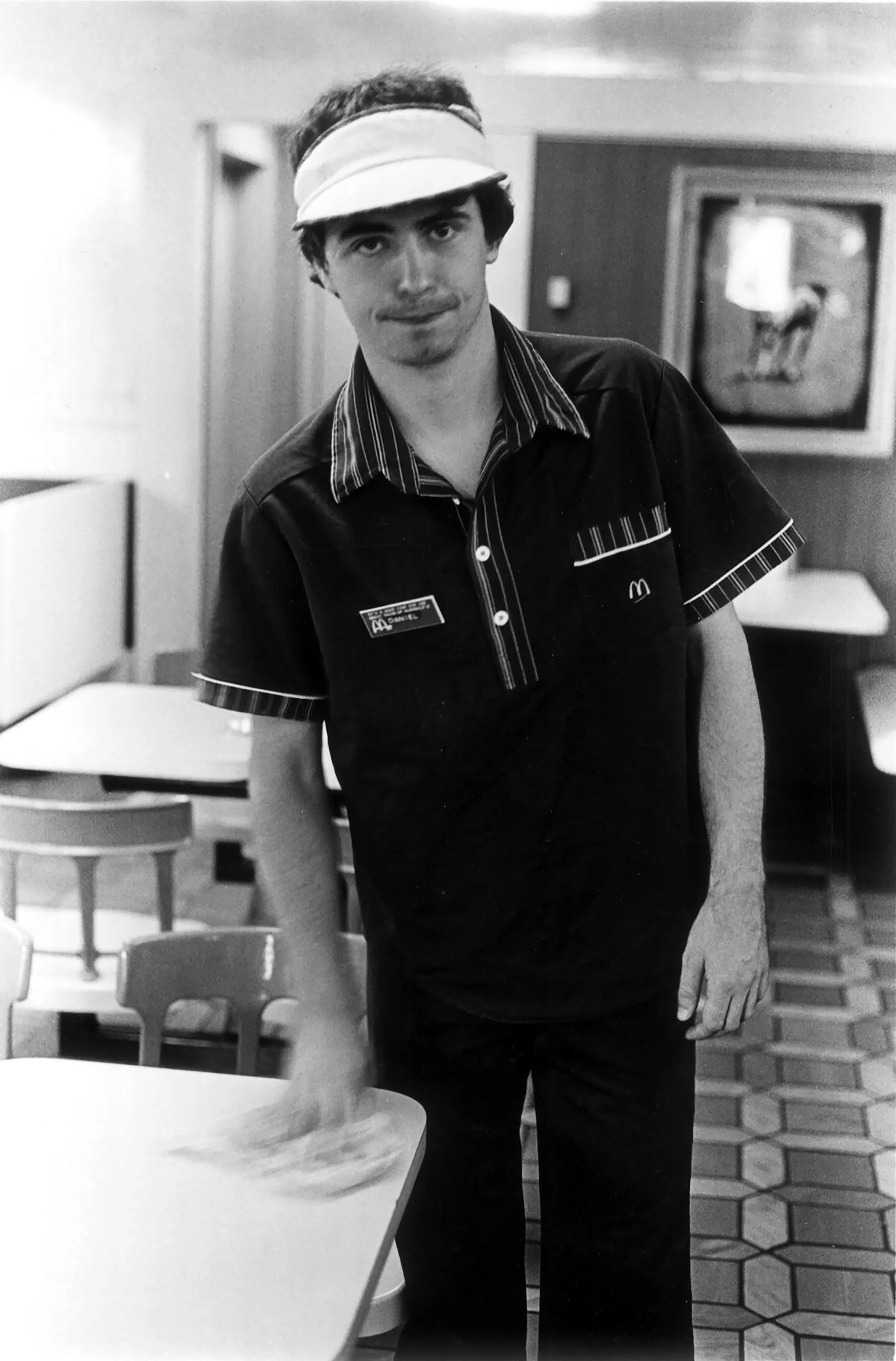
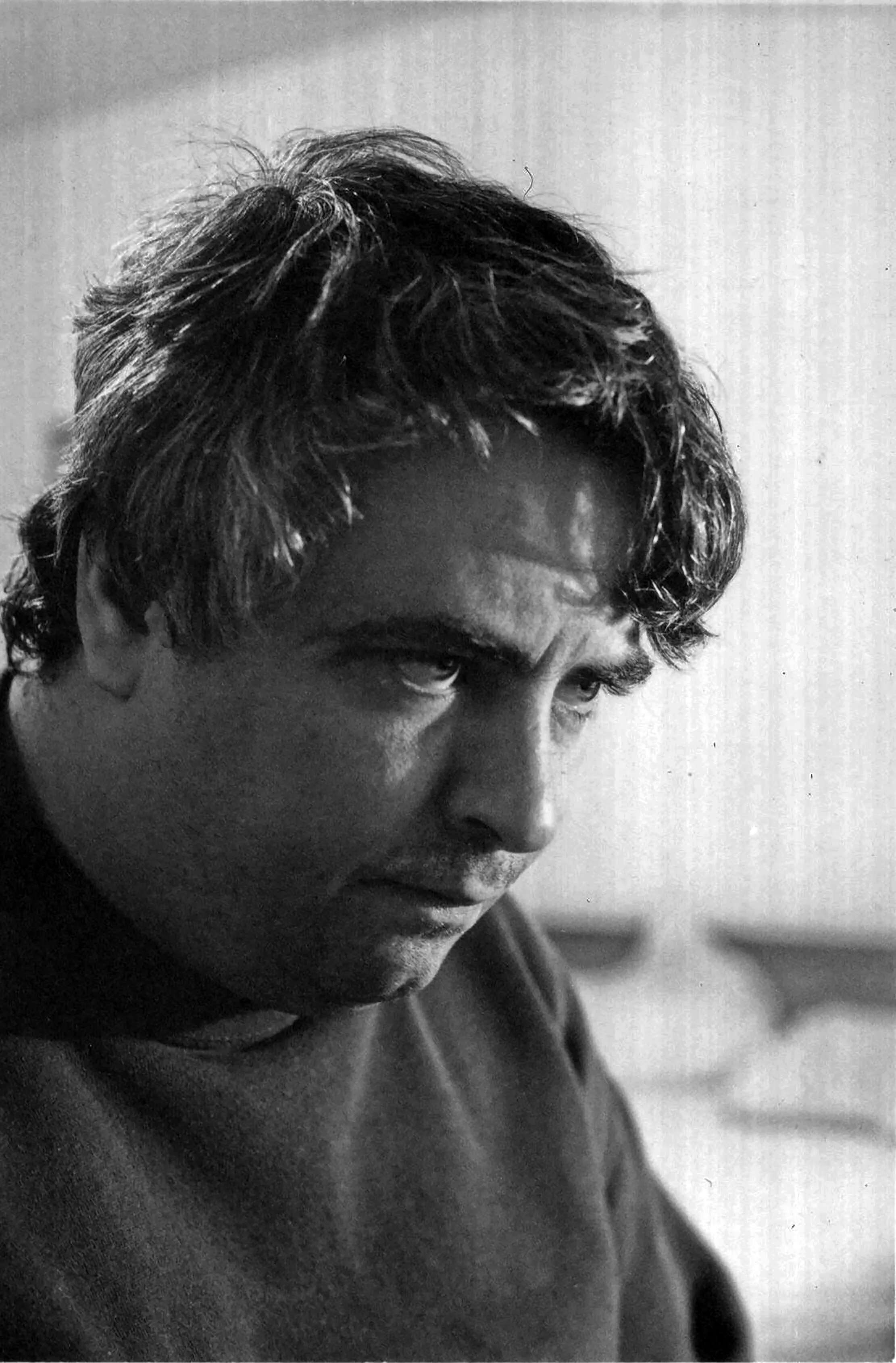
During the 1990s, Johnston’s career continued to flourish, although he also faced mental health challenges. Mental breakdowns drew attention, but Johnston used his platform to highlight the struggles artists faced, which in turn brought him the label of a misunderstood and eccentric figure. He toured with Sonic Youth but also spent time in jail after spray-painting the inside of the Statue of Liberty. The band members, who were wondering about his whereabouts, eventually discovered he had been arrested and bailed him out. This and similar stories further endeared him to the public, who appreciated his childlike demeanour and relatability.
Johnston considered art a tool through which he was able to escape his own mind, ravaged by manic depression, schizophrenia, and paranoid episodes. He didn’t limit himself to just one form; besides music and illustration, he also explored new media. However, his visual explorations received considerably less attention.
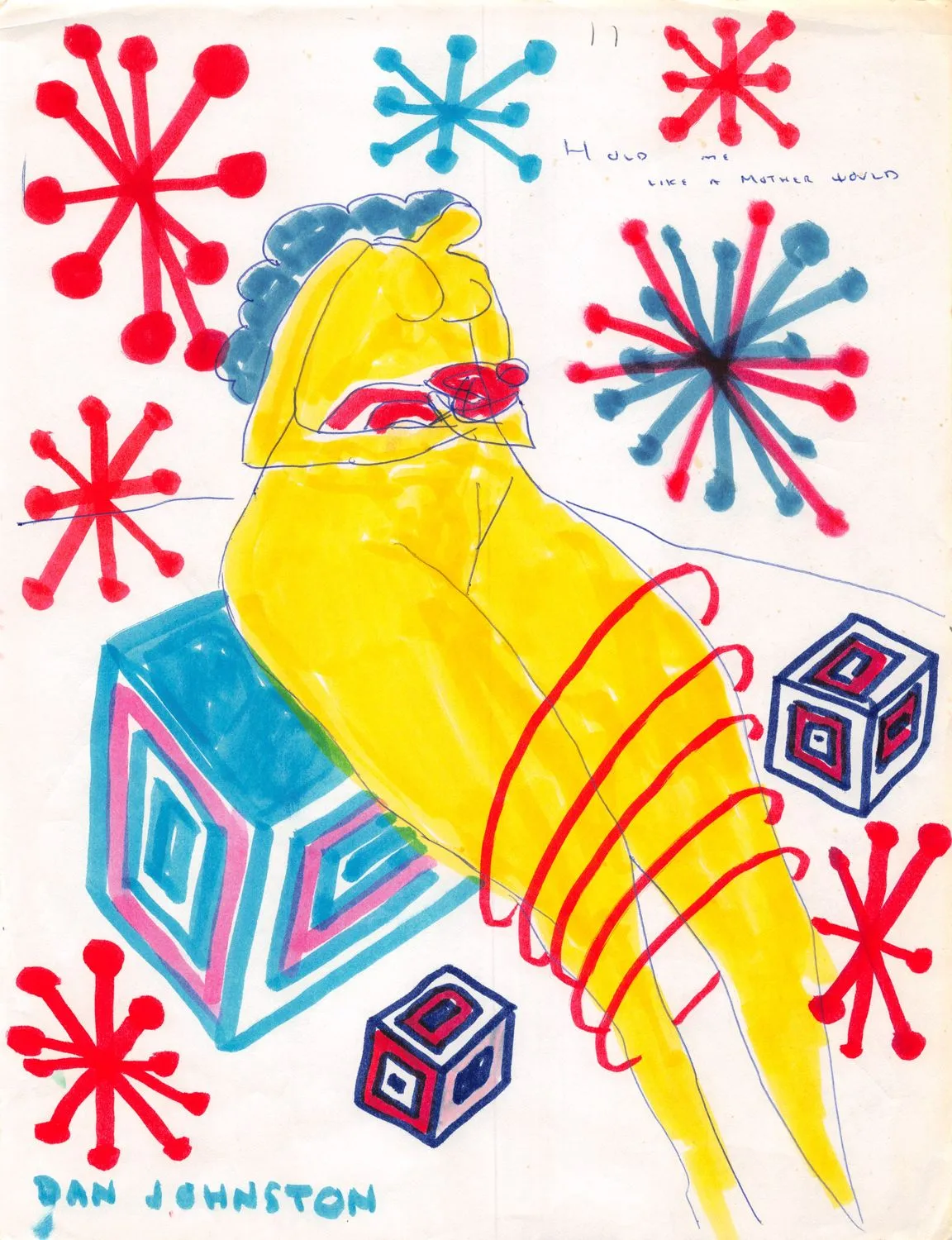

Hi, How Are You?
In 1992, Kurt Cobain, leader of the cult rock band Nirvana, began wearing a shirt featuring a cartoon of a frog asking, “Hi, How are you?” The image, one of many illustrations by Daniel Johnston, appeared on the cover of his 1983 album of the same title. The frog, now widely recognizable and known as Jeremiah the Frog, brought attention to Johnston’s visual practice as well.
What is noticeable when perusing his drawings is Johnston’s strong interest in cartoons and popular culture heroes, such as Captain America, the Hulk, as well as eyes, frogs, ducks, and similar characters. Rendered in magic marker, many of his drawings burst with color and energy. His vivid, psychedelic compositions are filled with fantastical imagery with recurring symbols. Among them is a free-floating eyeball (inspired by a horrendous image of a hanged dog he came upon as a teenager), standing in as a visual metaphor for innocence and paranoia alike.
“Like many of us, Johnston had his own idols. He was super influenced by the Beatles, so Paul McCartney shows up a lot. He has these recurring characters like the duck, the frog, and a lot of Marvel characters,” explained Addison Richley, the owner of des pair bookstore in LA, to Coveteur.
His creativity was so expansive that he combined fictionalized characters with living beings because, to him, it didn’t matter. They all meant something of equal importance.

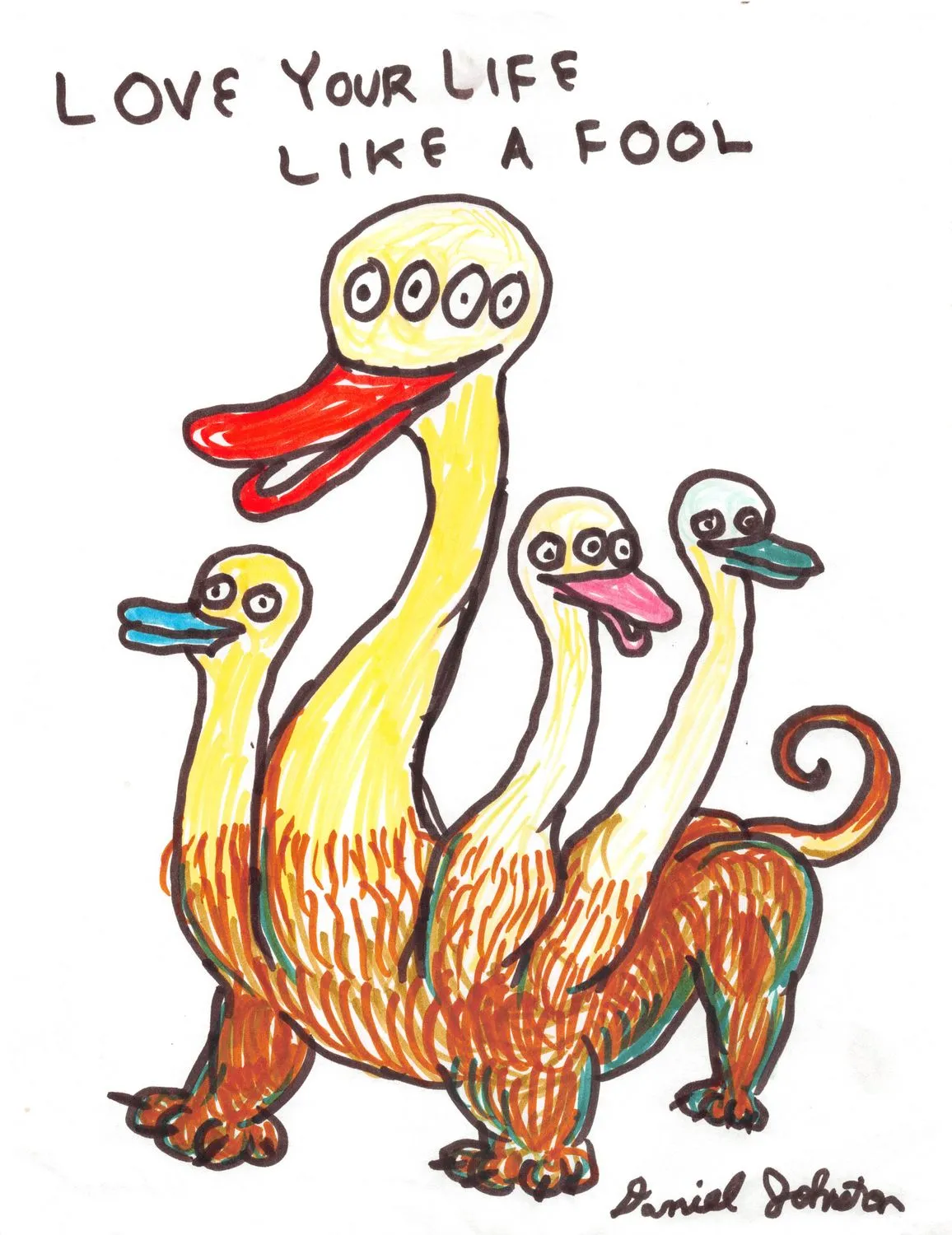
Following the illustrations for his self-published cassettes, in the early 2010s Johnston also began creating and publishing comic books. Among them is Space Ducks – An Infinite Comic Book of Musical Greatness, which was followed by an album and an app. Although his musical output is considered the most influential, visual practice was Johnston’s “first and longest-running passion,” as the press release for I Think, I Draw, I Am states.
The exhibition offers a comprehensive look at his practice, embracing his output from different years and creative periods. It features over 300 drawings and is the largest solo presentation of the artist’s work in New York to date. The works are put in dialogue, showing the interests, preoccupations, and emotional states of an artist who, for decades, toiled under the radar of the mainstream.
When considered iconographically, his drawings are masterpieces of existential tension, showing a world populated by Marvel heroes, biblical figures, and animals, where beliefs, struggles, and ideas reign freely, polarized between good and evil.
One of his drawings features Captain America with a speech bubble that reads, “I dream of good versus evil.” Humour and anxiety, religion and personal beliefs are combined in Johnston’s pieces masterfully, making his work relatable, self-reflexive, and universal.
“What I came to love about Daniel's art and music is the impulsiveness and imperfection of it all. He considered his audience, surely, but the work was never overcooked to accommodate anyone,” explains curator Lee Foster, co-owner of Electric Lady Studios and Curatorial Advisor for the Daniel Johnston Trust.
These were his heartfelt feelings, and what is left on the page are Daniel's simple truths—mistakes and all. He could be precise in his message, but he was never precious in his expression. ‘Better done than perfect,’ as the saying goes.
While fundamentally personal, Johnston’s drawings refer to universal themes such as the fight for justice, heroism, love, regret, redemption, and hope. Among his most emblematic figures are the already-mentioned Jeremiah the Frog and Casper the Friendly Ghost, often pitted against Lucifer and the evil version of Jeremiah, Vile Corrupt.


Johnston died at age 58, leaving behind a legacy of 15 albums and numerous illustrations, showing the complexity of his imagination and creative talent. Although later embraced by cultural figures including Cobain, Lana Del Rey, and David Bowie, he never reached widespread popularity or recognition in broader art circles. A significant milestone came with his inclusion in the 2006 Whitney Biennial, marking a shift in his status and his entry into the mainstream art world.
The question of where to situate his practice, of its belonging and influences, puzzled researchers and possibly hampered the art historicization of his oeuvre. Much of this, undoubtedly, stems from his status as a person with mental health challenges, which often relegated his practice to the realms of outsider or naïve art. It took decades for the art world to accept art made by minorities on an equal basis, and cultural, racial, and economic prejudices often shaped the formation of narratives in art history.
With broader societal changes in recent decades, the art world ‘rediscovered’ artists who played against the main tune: those who explored less-frequented spaces and social, economic, and mental margins, bringing light to often overlooked aspects of society.
The figure of Daniel Johnston looms large in this sense. Besides familiar figures from pop culture, his visual works are filled with inscriptions that are simple yet emotionally deep and penetrating. Anxiety, love, and other universal themes are rendered with a directedness and immediacy rarely found; this singular, humorous, and yet profound approach connects him to audiences seeking simple but deeply moving expressions—where vulnerability is not hidden, but proudly exposed and cherished.
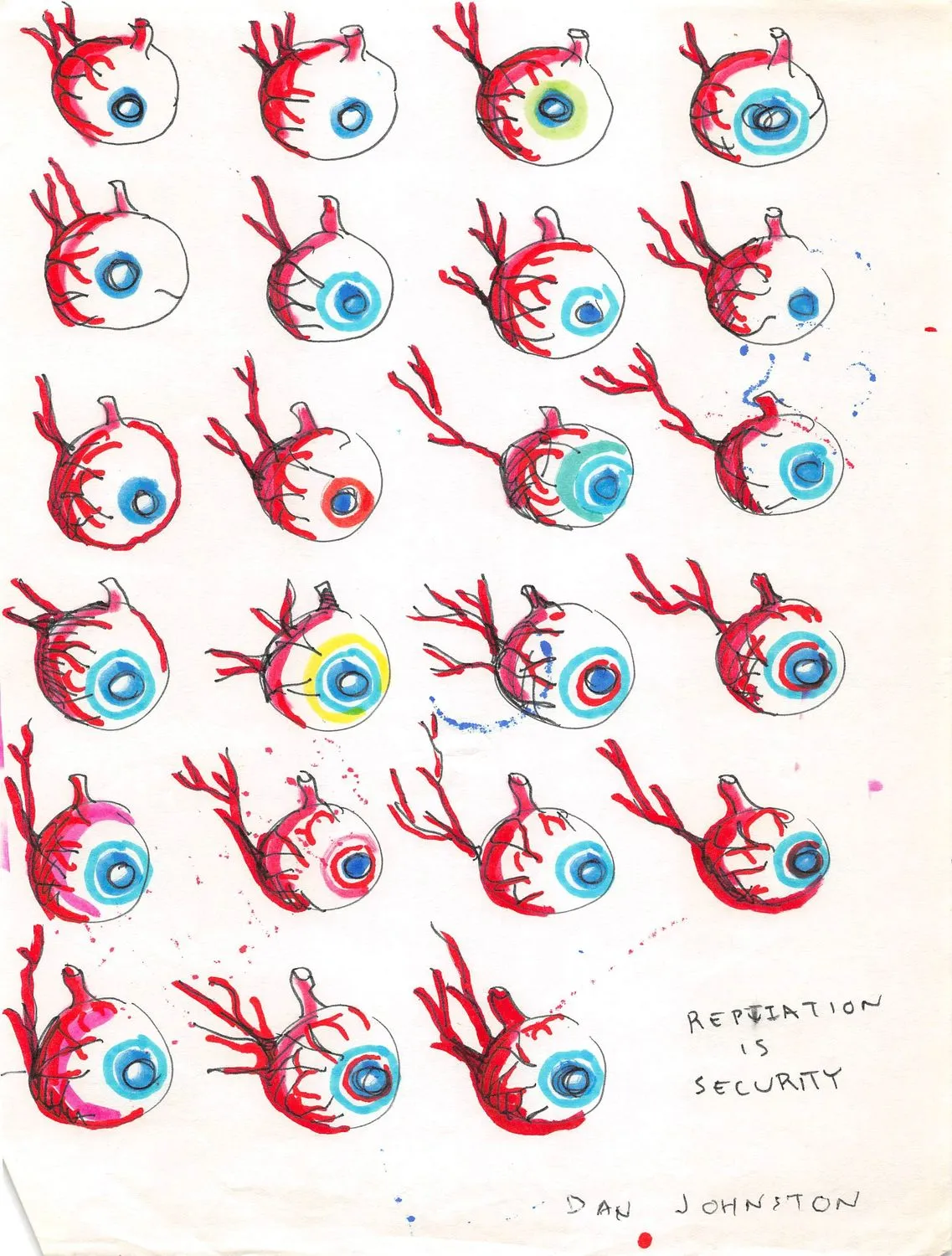

Besides his art, Johnston is remembered for his engagement in removing the stigma surrounding mental illness and for broadening the public conversation. Inspired by him, local Austin mental health professionals initiated the Hi, How Are You? Project, aiming to educate young adults on the importance of mental health. In 2015, a short documentary film Hi, How Are You Daniel Johnston? was released, featuring the artist talking to his past self and taking the audience inside his mind. He also openly discussed the use of different medications for his mental health, all the while urging himself to “choose the light.”
In looking back at his legacy today, one is struck by the sincerity Johnston offered his audiences—an unfiltered glimpse into the human condition and psyche, tormented by the ghosts of the 20th century and moving uncertainly into an undecided future.
Beyond the artistic value of his work, whose openness and directness resonated with many, Johnston’s legacy lies in the permission his art and music granted: to be flawed and vulnerable, to confront mental health struggles without shame, and to carve out a space for oneself.
Between innocence and truth, sorrow and hope, Johnston’s art reaffirmed the value of voices that don’t fit the mold, making space for their presence and carrying that legacy into the future.
The exhibition Daniel Johnston: I Think, I Draw, I Am will be on view at Pioneer Works in New York City until August 10th, 2025.

